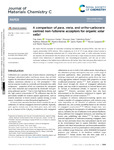A comparison of para, meta, and ortho-carborane centred non-fullerene acceptors for organic solar cells

Use this link to cite
http://hdl.handle.net/2183/32938Collections
- Investigación (EPEF) [590]
Metadata
Show full item recordTitle
A comparison of para, meta, and ortho-carborane centred non-fullerene acceptors for organic solar cellsAuthor(s)
Date
2023-03-28Citation
ANIÉS, F., FURLAN, F., QIAO, Z., PIRELA, V., BIDWELL, M., RIMMELE, M., MARTÍN, J., GASPARINI, N. y HEENEY, M., 2023. A comparison of para , meta , and ortho -carborane centred non-fullerene acceptors for organic solar cells. 2023. Cambridge, U.K. : Royal Society of Chemistry. Journal of materials chemistry., 11.
Abstract
[Abstract]: We report the first examples of carborane-containing non-fullerene acceptors (NFAs), and their use in organic photovoltaic (OPV) devices. NFAs employing an A–D–A′–D–A type design centred around a central electron withdrawing carborane unit (A′), using either para, meta, or ortho-carborane isomers are reported. We demonstrate that the nature of the isomer has a major impact on device performance, despite minor differences in optoelectronic and morphological properties, with the use of ortho-carborane resulting in the highest device efficiencies. We further show that end-group fluorination is an efficient strategy to modulate energy levels and improve device performance of such NFAs.
Editor version
Rights
Attribution 3.0 Unported
ISSN
2050-7534






